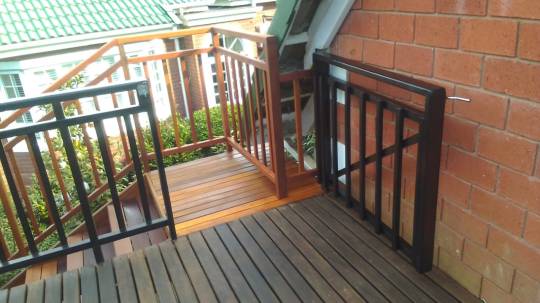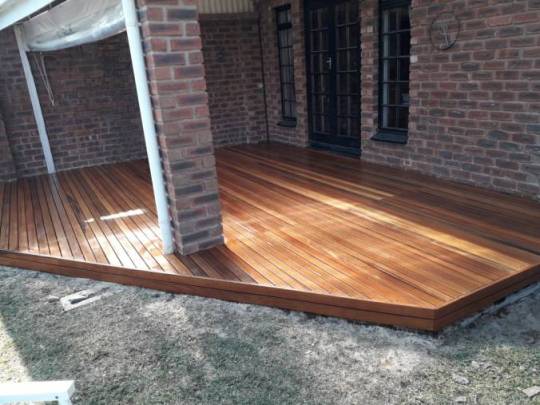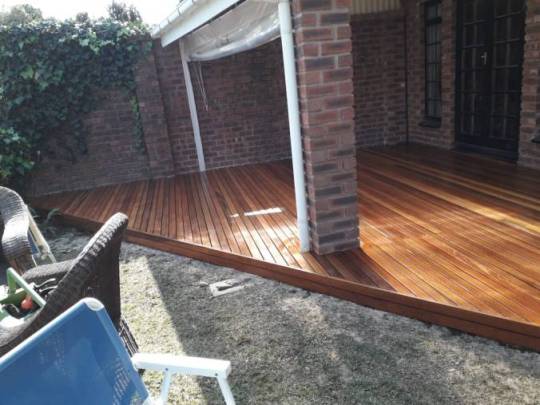#Bälau
Explore tagged Tumblr posts
Text
Balau Wooden Stairs in Hillcrest

View On WordPress
0 notes
Text
This slideshow requires JavaScript.
This wooden deck we built in Waterfall, Durban was part of a new build at Focus on Ithemba along Blessing Ninela Road, Waterfall. They were building a new boardroom and office complex and part of the design was a wooden exterior deck.
The job was referred to us by Mass Landscapes, Miles Steenhuysen, who was contracted to do the landscaping. His details can be found here.
In consultation with Miles and the project manager we designed the deck so as to flow around this office complex comfortably and aesthetically and within budget.
The structure of the deck was the standard H3 and H4 CCA treated pine. H3 and H4 CCA treated pine is suitable for outdoors decks. H3 has a life span of a minimum of 50 years and correctly treated H4 pine can live in the ground in constant contact with wet soil for a minimum of 20 years. These are guidelines provided by www.sawpa.co.za. The full document can be found here.
We used 19 x 68mm yellow balau deck boards as the surface. There is a difference between red and yellow balau. The red balau, which is a bit cheaper in South Africa, is a lot more porous and less dense than the yellow balau and as a result will absorb and retain water more easily than yellow balau and will therefore probably rot more quickly. We use only yellow balau which is the most cost-effective hardwood for decking in South Africa. It is not correct to assume that treated pine is cheaper than balau deck boards. Please see here for an article on the difference between balau and pine in decking.
The building we were attaching this deck to was not completely square with itself as it was an old building that had been extended. As such one needs to be very careful when building wooden decks against walls that aren’t square or straight. At some point there will need to be a correction to eliminate the problem and it needs to occur where it is less visible. Either the deck can be built square to itself but it will highlight the errors on the building or the deck needs to be built off square to take up any difference between the building and the deck in a place where it is less visible and can be concealed.
Screw holes we filled with epoxy and sanded flat. The epoxy used was a clear epoxy which was mixed with saw dust to match the colour. The epoxy in the screw holes prevents water sitting in the counter sunk screw hole and being absorbed up the end grain which would cause rot to set in more quickly. The deck can be oiled after sanding or left to grey naturally.
For a free no obligation quote on timber decking and related construction, we can be contacted on 031 – 762 1795 or use the contact us form below.
[contact-form] Wooden Balau Deck Built Waterfall, Durban July 2018 This wooden deck we built in Waterfall, Durban was part of a new build at Focus on Ithemba along Blessing Ninela Road, Waterfall.
#affordable sundecks#Bälau#cca pine#Decking#decks#Durban#hillcrest#kwa zulu natal#kzn#north coast#pool decks#South Africa#south coast#Sun Decks#Sundecks#timber#treated pine#upper highway#waterfall#wood#wooden
2 notes
·
View notes
Text
This slideshow requires JavaScript.
We engaged with a landscaper and garden designer on this balau pool deck project in Kloof, Durban to provide a solution for the client who wanted an area alongside their pool that they could utilise more. Before the project started there was the standard paved area of about 1m alongside the pool which was bordered by grass of about 1m and then a flower bed, before dropping down a small bank to the rest of the garden. The client wanted to increase the size of usable area alongside the pool.
Initial designs were to have a very similar layout as per the pics above with a semi-circle sort of node protruding over the bank to gain height and create a look out area overlooking the Kloof Gorge. This proved to be out of budget and would probably have resulted in doubling up sitting area as there was already a large tiled verandah extending out from the living area doors. The final design was settled on which is what you see in the pics.
We needed to excavate some of the garden down and move this top soil for use in another area of the garden. It is always recommended that sufficient space be left below the deck and below the bottom of the lower most bearer or joist to allow enough air flow to dissipate and evaporate any water that settles below the deck. Too often I have seen deck boards rotting prematurely due to insufficient space being left below. Water gets trapped below and the underside of the deck and structure remains damp. I normally recommend at least 150mm below the lowest point of the structure. Once we had enough space below we installed our structure using H3 CCA treated pine. Please see here for an article on the use of CCA Treated pine as structures for decks and balau as deck boards. All cut ends of treated pine, as a matter of course, are re treated with an approved end sealer. When a CCA treated piece of pine is cut it exposes a section that is not treated and can accelerate rot.
Post to ground are set in concrete and installed at the correct distance on the bearers to stop any bounce in the bearer and to provide enough support to prevent the bearer breaking. There are guidelines supplied by engineers for distances that these supports need to be installed. These posts need to be H4 CCA treated pine as they are in constant contact with wet soil.
A lot of this job involved lining up existing paving, pool copings, patio etc. to the deck so the lines were seamless and everything ties in neatly. A walkway, as can be seen from the pics, was created to run alongside the existing raised patio for access to the rest of the garden.
In finishing our decks we fill the screw holes with a clear epoxy mixed with saw dust to match the colour as closely as possible and then grind and sand it flat. Standard wood filler doesn’t quite do the trick and fails with exposure to weather. The filling of screw holes is a very important aspect of deck building. It prevents water sitting in the counter sunk screw hole which would then travel up the end grain of the balau and cause early rotting of the balau deck boards. We use a clear epoxy so that we can match the colour to the deck boards. Off the shelf epoxies are either grey or white in colour and don’t take the saw dust that well to match the colour. Also these epoxies dry very hard. It is better to use an epoxy that is semi pliable when dry. Through seasons of dry and wet, hot and cold, the inside diameter of the counter sunk screw hole will vary ever so slightly. If the epoxy has dried too hard it will cause it to pop out leaving a weak spot on the balau deck board. During maintenance intervals these should be checked and replaced if they have in fact popped.
The deck was oiled using a zero wax content product. The beauty of oil is that it soaks into the wood and therefore cannot peel and flake. A peeling deck is an expensive deck to maintain because you would need to sand off the coating completely to avoid a patchy finish when re-applying the coating. Whereas an oil simply degrades due to exposure to UV over time. A pressure wash and re-oil is all you need to do at maintenance intervals which is relatively inexpensive and easy to do as opposed to sanding the deck again. The oil also allows the natural beauty of the wood to shine through resulting in a more natural wood looking product. Coatings give them the effect of a painted deck especially over time when layer after layer has been applied.
For a free no obligation quote on your timber balau decking, walkways, pergolas and other outdoor timber products, please call us on 031 – 762 1795 or use the contact us form below. We operate throughout KZN.
[contact-form] Balau pool deck and walkway – Kloof, Durban We engaged with a landscaper and garden designer on this balau pool deck project in Kloof, Durban to provide a solution for the client who wanted an area alongside their pool that they could utilise more.
#Bälau#CCA#composite deck boards#deck#deck boards#Durban#garappa#H3 CCA Treated#hillcrest#kloof#kzn#massa#Massaranduba#paving#Pine#pool deck#South Africa#Sun Deck#timber#treated#upper highway#walkway#wood#wooden
1 note
·
View note
Text
Wooden Balau Deck built in Cotswold Downs, Hillcrest
Wooden Balau Deck built in Cotswold Downs, Hillcrest
This wooden balau deck built in Cotswold Downs in July 2019 was built primarily to cover the JoJo tanks which were being housed below. There were various challenges in getting the beam across the span around the pipes that led into the tanks but with a few tricks we managed to hang a beam from above rather than secure it from below.







The balustrade was built using balau and marine grade…
View On WordPress
#Bälau#CCA Treated#Cotswold Downs#crestholme#deck#Decking#Durban#forest hills#garappa#hillcrest#kloof#massa#Massaranduba#Patio#Pine#pool deck#South Africa#Sun Deck#Sundeck#timber#upper highway#waterfall#wood#wooden
0 notes
Text
Wooden balau deck built in Hillcrest
Wooden balau deck built in Hillcrest
This wooden balau deck was built in Hillcrest. It was built on top of existing slasto. When building on top of a previously laid substrate one can build directly on top of it rather than removing the paving or slasto. It helps with water flow below the deck keeping it drier and thus preventing premature rotting due to excess moisture for prolonged periods of time below the deck.





When…
View On WordPress
#balitto#Ballito#ballitto#Bälau#CCA Treated#deck#Decking#decking planks#decking wood#Durban#durban north#forest hills#highway area#hillcrest#izinga#kloof#kzn#Patio#pinetown#pool deck#South Africa#Sun Deck#Sundeck#timber#treated pine#umhlanga#upper highway#waterfall#westville#wood
0 notes
Photo

0 notes

